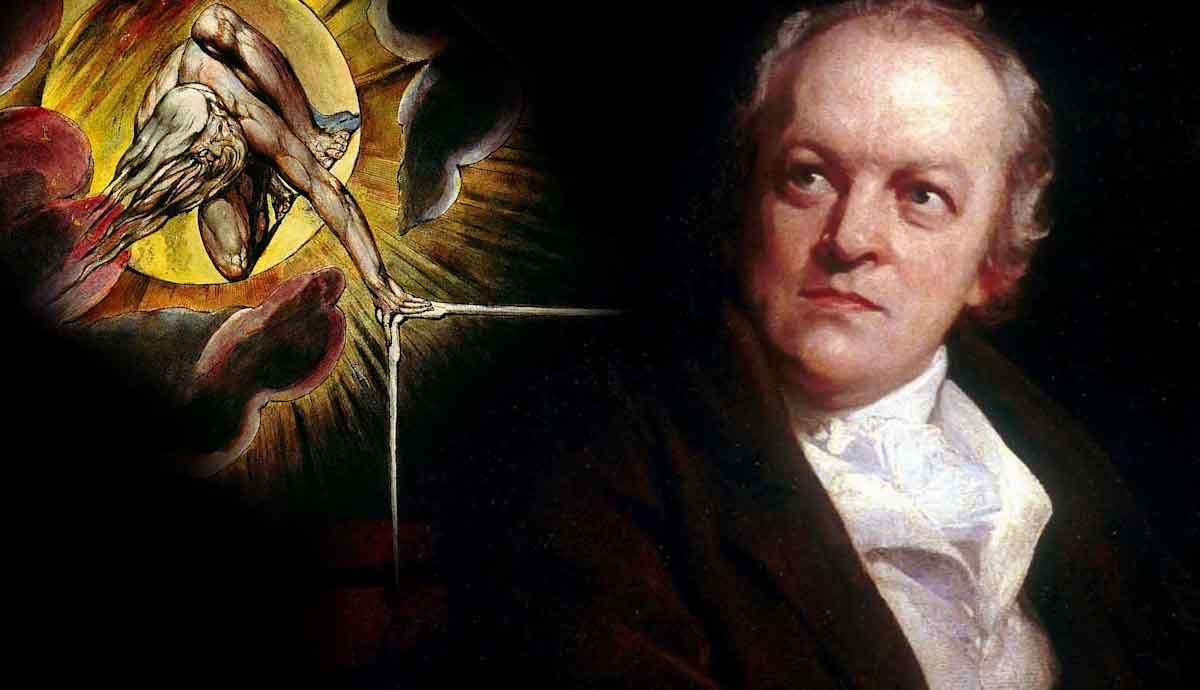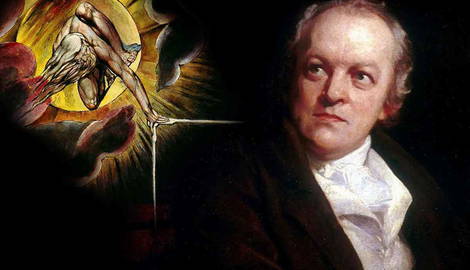
Although William Blake received hardly any recognition during his lifetime, he’s now known as one of the most well-known Romantic artists, specializing in poetry, engravings, and paintings. Inspired by his religious upbringing and otherworldly visions, he developed his own mythologies and philosophies that remain influential today. His first recorded vision was at four years old when he saw God’s face in his window. The spirit world was very real to him from a young age and inspired all his creations. Here is an outline of his early rebellion against the Church of England, how this led to philosophical musings that inspired his spiritual beliefs, and an example of the four mindsets he identified in a character he brought to life.
William Blake: A Religious Background

Blake’s mother Catherine was briefly a member of the Moravian church, which began in Germany in 1750 and made its way to England. An extension from the Protestant denomination and sharing parallels with Methodism at the time, their belief system was characteristically emotionally charged and vision-forward. Even though she left the church before meeting William Blake’s father James, her lingering spiritual views influenced William.
Growing up, the Blake family was believed to be a part of an undisclosed dissenter sect separated from the Church of England. Dissenters were motivated by human reason and listening to the self, not just the word of God. He was still baptized and christened by the rites of the Church but always rebelled in thought against their orthodox beliefs.
His parents were also guided by the doctrines of Swedenborgism, started by a man in 1744 who believed he was called by Jesus to establish the Church of New Jerusalem. The creator Swedenborg believed all living beings correspond out of divine love on this earth to spiritual realms that we can’t see. Blake was heavily influenced by these nonconformist ideas although he didn’t support the belief system altogether. In Blake’s well-known book that he created in 1885, the title The Marriage of Heaven and Hell was a satirical reference to Swedenborg’s writings named Heaven and Hell, which Blake disagreed with.
William Blake and the Church of England

Since Blake was young, he revolted against the concept of organized religion, specifically the Church of England. He felt it provided no space for freedom and constricted thought and behavior within literal man-made walls. The heavy emphasis on loyalty the followers were forced to hold towards the Church itself was unsettling to him. The control that authority in leadership had over members seemed unfair and the hierarchy too legalistic in his eyes.
Within the Church, the one true God is preached, and the expectation is everyone must perceive God in this one way. This leaves no room for questioning or reinterpretations, which bothered Blake especially since he had experienced God in many different ways his whole life. Blake also disagreed with the black and white dichotomies found in Christian dogma, such as the objectively stated concepts of good and evil. In contrast, he embraced evil, which is an example of the extreme questioning his mind wandered to in defiance of these imposed beliefs.
Another foundational opposite presented is heaven and hell, which Blake disputes this traditional idea of the afterlives. He believed without the deep fear of hell that the Church ingrains, they wouldn’t exist. This means that the image of hell was upkeeped to keep followers returning, which Blake thought was absurd. The arguments he cast against the Church were what led him to create his own line of thinking.
William Blake and the States of Mind

Blake believed there was so much more to discover beyond what can be perceived with the human eye. Since he was a child, he had been utilizing his mind’s eye, seeing through the physical plane. Two of his most memorable visions as a youth involved angels convening in the trees and an encounter with the prophet Ezekiel. Although he was against organized religion, the Bible itself was a major inspiration for him and provoked his spiritual sightings. Instead of only following this holy book, however, he coupled the truth he found within The Word with the truth that originated within himself. This paralleled the general concept held by the Dissenters that there is value in not burying the self completely.
To him, the human imagination had become twisted, conditioned to filter out meaningful stimuli and focus on logic and systems. That’s why he uncovered four states of mind that enable a fuller exercise of the imagination’s potential. He recognized the power of harnessing the ability to identify which state one was existing in at different times to reach a deeper understanding at the individual and societal level. The four states are Ulro, Generation, Beulah, and Eden or Eternity.
Ulro

Ulro is the state in which he believed many are trapped. It serves a purpose, but only living in this space is limiting. It’s defined by quantitative information, prioritizing measurement and tangible data while ignoring anything on the other side of the restrictive walls of the material world. When solving logistical problems, this form of imagination leads to rational solutions. However, it doesn’t extend to problems related to questioning the true essence of life or contemplating death. That’s where the next condition of consciousness adds worth. In Blake’s mythology, Urizen, seen in his artwork, was the god of reason and was the architect of Ulro.
Generation

Existing in the state of Generation leads to acknowledgement of the cyclical elements of life. Productivity is enhanced and building sustainable systems is more efficient in this space. There’s more room for pondering the creation of life on a biological scale and how all components of the universe serve a function in sustaining the human race. However, without the influences of the following progressive states of mind, the advantages of Generation can settle into a cycle of pure consumption as reproduction is perfected through manufacturing and nothing else. Blake’s drawing illustrates an ideal world functioning with an Ulro mindset on the brink of disruption in need of the Generation mindset
Beulah

To avoid the mentality of survival of the fittest, the state of Beulah comes into play. As a more emotionally charged mindset, it leads to deepening of human connection and an awareness of the beauty in the world. The concept of the soul is welcomed, and love is infiltrated into a previously cold and calculated perception of existence.
Acceptance of a divine force is more within reach and creativity blooms with a new appreciation of the natural surroundings. Morality is developed at this stage and justice prevails as relationships are prioritized. As with the other states, staying stuck in Beulah leads to corruption, and the desire to possess and control others can become overpowering. Blake mentions Beulah in his poem Milton, which explores the connection between preexisting and living writers
Eternity

The final form of imagination is Eternity which can lead to the ultimate balance of all states. It’s achieved when full confidence is placed in imagination and objectivity is combined with subjectivity. The infiniteness of life and the fluidity of time is realized. Blake believed geniuses of scientific invention and artistic creation had reached this level of enlightenment. The virtues of forgiveness and mercy are completely adopted, and love can be experienced towards enemies.
The fear felt in the other states surrounding death disappears as it’s understood to be a part of everyday life. The feeling of ownership over one’s life is recognized to be an illusion. Life is provided through timeless love which works together with death, stripping the horror away from it. Blake cared deeply about the physical and spiritual world and believed the way to preserve the earth was to be open to the divine, the gods and psychic beings that visited him often. He was confident that discounting the world beyond the reality in front of us was discounting a part of the self.
The Story of Los: A Mindset in Action

Los is a character in the mythological world Blake developed that represents imagination and is known as the eternal prophet. He is a blacksmith and hammers on a forge as if creating the rhythm of a beating heart. As a fallen entity, he produces consciousness which leads to the birth of humans. He orchestrates natural cycles, which contributes to the production of artwork and the imagination’s ability to thrive through creation.
The mindset of Generation is one that Los existed in often. The tools he uses lead to the formation of something new, unlike a tool like a compass one may use with the Ulro mindset. A significant goal of his was to build the city of Golgonooza, where humans could encounter divinity. Through harnessing his imagination and desiring creation on a massive scale, he faces the harsh reality once reaching Eternity that his idealistic vision was impossible to achieve on earth. Although the utopian city he wished to build in the human realm was hopeless, the pursuit led him to discover Eternity. The story of Los illustrates the power of the mindsets when combined and the unconventional path each individual may take to get a glimpse of Eternity.
In addition to William Blake’s incredible artistic talent seen in his paintings and engravings and his way with words through poetry, his creation of entirely new mythology reveals his true genius. He manifested his complex inner world through his written musings on philosophy and spirituality. His timeless legacy will surely live on in the art world and beyond.










